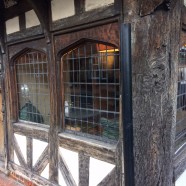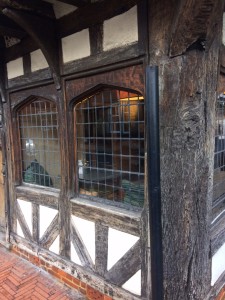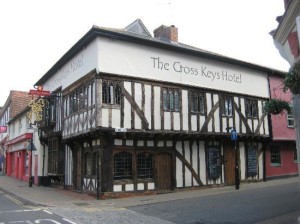
The Cross Keys needed stained glass repairs in Saffron Walden
A challenging repair because I did not want to change the whole leaded light as the top portion was entirely sound. The bottom had been pushed out by diners in the restaurant leaning on the glass – the above picture has the bottom two rows of glass quarries inserted into the existing window.
The Cross Keys has recently been crownd the overall winner of the Channel 4 programme Four in a Bed The show involves four B&B owners taking turns staying at each other’s hotels, requiring them to inspect the rooms and sample the dinner and breakfast menus.
The next morning, each couple will then pay what they consider fair for their stay and the winning hotel is the one named best value for money.
The local papers include reports of the triumph – Saffron Walden Reporter and Cambridge Evening News
Located on the High Street of Saffron Walden the Cross keys is a timber-framed building dating back to the 15th Century and is said to be haunted by a Cromwellian soldier.
Staff and visitors have reputedly heard phantom footsteps walking up and down the corridors and each Christmas Eve it is said the soldier runs down a dead end passageway and then disappears without a trace
It was originally Known as the Bull in 1709, but had become the Cross Keys by 1778.
The original name of the town in north west Essex was simply ‘Walden’, from the Saxon words for ‘Valley of the Britons’. It gained the prefix ‘Saffron’ when it became a centre for cultivating crocuses in the medieval period. Though the autumn-flowering crocuses actual produced a purple flower, they were used to make perfume, and a yellow dye for cloth, hence the name. The crocus was also used to flavour food and in medicinal concoctions for catarrh. The medieval prosperity brought by the crocus trade is evident by the number of attractive timber-framed buildings clustered around the market square.
The area was settled from prehistoric times, and there are ancient earthwork remains near the town. Much of the street layout we see today in the centre of Saffron Walden follows the course of the bailey enclosure of a 12th century castle built by Geoffrey de Mandeville, Earl of Essex. Mandeville also founded a Benedictine Priory and established the first market here. He rebelled against the crown and lost his life, and the castle eventually crumbled into a ruin. It stands today near the museum, one of the oldest purpose-built museums in the country, founded in 1835.


